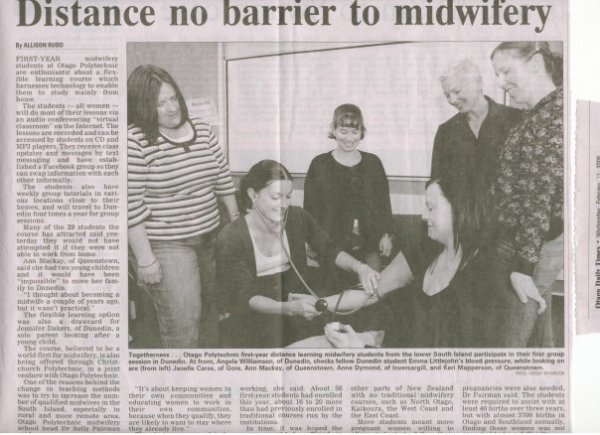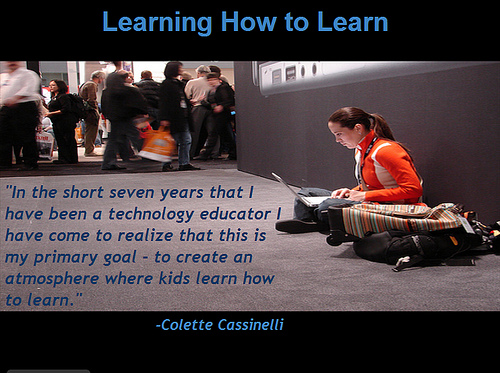I have been blogging about the development and progress of our new programme for undergraduate midwifery education. 
This photo graph and article appeared in the Otago Daily Times during our first intensive in January.
Our new programme has a longer academic year than our previous programme, beginning earlier in the year and finishing later. Instead of being divided into two semesters our new programme is divided into three trimesters. Each trimester begins with the students coming together in class for two weeks of sharing, learning, doing class presentations (which are part of the assessment processs) and having some face to face lectures. It is really good to see everyone back together. We all know each other quite a bit better and there is an air of cammeraderie and friendship.
How is it going?
We decided to get some feedback from the students about how the programme is going for them. What is working well and what they feel needs to change.
Yesterday the students got into groups and discussed this then fed back to the class. This is what I took out of this discussion.
It was overwhelmingly postive. The students said they are enjoying the course and the online learning. There were only one or two who said they felt they would prefer to be in class and have lectures, most are more than happy with being able to engage with the learning resources when they want to and in the way that suits them.
Online resources:
Feedback on the online learning resources was very positive. Most like this way of learnign and enjoy the quizzes and activities. They have aparticular topic that they cover each week and are given a list of questions related to that topic to investigate and discuss in the Elluminate session later in the week. The students wanted the questions to be posted at the same time as the modules.
Online quizzes
The learning resources are interspersed with quizzes and case studies to make the students think and to improve the learning experience. Most of the students enjoy these althous some acknowledge that they feel now compulsion to do them and so do not bother. They felt it might help if the Quiz had to be completed before progressing on with the module and this is something I am going to look into. They particularly liked doing the crosswords but some of the quizzes were less useful. In particular they mentioned a memory game that I had set up so I will not bother with that one again. I have had trouble getting crowwords to work for me so I will have to find out how I can do this from those that are managing to get crosswords up. I was told Hot potatoes was a good programme for this and I have tried but have not managed to master it yet. I have done some lovely crosswords in Eclipse but i cannot get them to load properly so that the students can use them. These activites are formative assessments which are recognised as an integral part of online learning and so it is important that we find ways to help the students engage with these to improve their learning and the retention of the material they are covering.
Elluminate,
We use Elluminate for weekly class tutorials which the whole class can attend online. Again most really appreciate this and find these tutorials useful the questions that have been put to them in the online learning for the week are discussed here. A couple of students said they would prefer video conference . There was also some discussion about the possibility of having a class session for those in Southland and Dunedin who can attend while doing the same think on Elluminate for those who cannot attend or prefer to be online. This would be very tricky I think as there is alot for the lecturer to consider in facilitating an Elluminate session, text chat, voice chat and running the material on the white board screen. I think trying to manage this online and face to face at the same time would be too difficult and we do not have the manpower to run session twice.
Some students are very willing to discuss issues in Elluminate, some prefer just to text. some said they would be happy to speak face to face but do not feel so confident online. They wanted to point out that if they do not speak it does not mean that they are not engaging or learning. Some just like to sit and listen and learn. This is very similar to the classroom situation and it seems to be the same people who are happy to talk in class that are the ones who are happy to speak online. The lack of body language cues was discussed as a disadvantage.
Practice skills
The students are really enjoying the midwifery practice experiences they are getting. They are aware that thsi is much more than the previous students had and they really appreciate this. I had hoped that some of the skills assessment would be able to be done in an actual clinical setting with the midwives in practice but this is proving very difficult to achieve. The midwives feel a bit threatened and overwhelmed by these skills assessment forms and this is not happening so we will have to go back to doing this in the class room setting.
Small group tutorials
The students really like the small group tutorials and most feel that these are working really well for them, helping with the course work and learning and providing an opportunity to debrief and learn together.
Reflection
Overall it seems that the programme is working well for the students. I would like to try to do something to help them engage more with the formative assessments we have in place and will look into the idea of making these compulsory to complete before moving on. At least for some of the quizzes. I think the change to doing some of the skills assessment in the weekly face to face session will be positive. I have been reluctant to do this previously as it would be outside the topics time tabled for the week and was worried that this may confuse the students but I think they can all see the rationale and I think this will work. It is very pleasing that this feedback was so postiive. We also gave the students a questionnaire to complete and that is being analysed. It will be interesting to see if these results are any different to this feedback.



